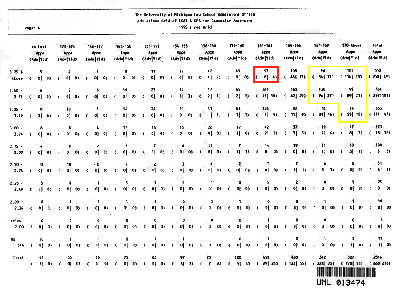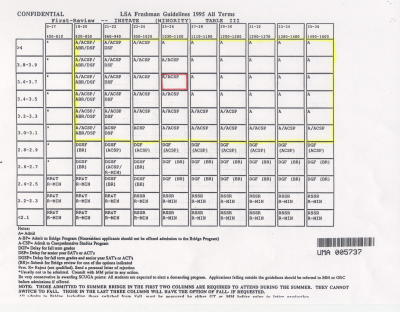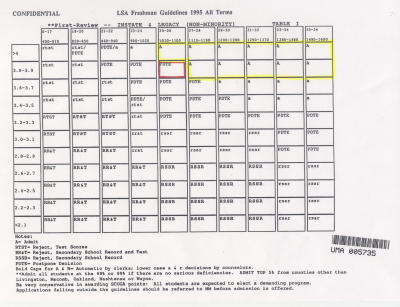The Mechanics of Race at the University of Michigan
There were two separate admissions policies at stake in the Michigan cases: the UM’s undergraduate admissions system (Gratz) and the UM’s law school admissions system (Grutter). The mechanics of each system make clear that UM’s purpose was to ensure a particular racial mix of students as an end in itself. The undergraduate system made this particularly clear.
Prior to 1998, the undergraduate system ranked students according to their SAT scores and GPA utilizing a “grid” consisting of boxes representing different combinations of scores and grades. On the basis of instructions contained within each grid box, admissions counselors automatically accepted, rejected, or held for further review applicants based solely on grades and test scores.
The grids contained separate instructions depending on the race of the applicant. In some years, there were separate grids (with separate instructions) for students of a preferred racial group. In other years, there was a single grid with separate instructions in each box. During the latter years, the instructions in some boxes, authorized admissions counselors to automatically accept minority applicants. The same boxes instructed counselors to hold non-minority applicants with exactly the same grades and test scores for further review.
As a result of the different instructions, an applicant of a preferred racial group with one set of grades and SAT scores would stand almost a 100% chance of admission, while a non-racially preferred candidate with the same set of grades and SAT scores might stand a 3% chance of admission. Jennifer Gratz and Patrick Hamacher had a good but not overwhelming chance of being accepted, but would have had a nearly 100% chance of acceptance if they had been members of a preferred racial group.
The Grids
Below are links to grids used by the University of Michigan until 1995 to determine undergraduate admission based on race. Ranges of ACT and SAT scores form the columns of each chart and ranges of GPAs form the rows of each chart. The letter code in each cell of the grid determines whether an applicant is admitted, wait-listed or rejected. For instance, any code beginning with “A” means an applicant is automatically admitted by a clerk. Any letter beginning with a lower case “a” is passed to a counselor for decision as opposed to an automatic decision made by a clerk.
In the grid below, applicants falling within the area outlined in yellow were guaranteed admission. (Click on the grid below to display a larger version in a separate window.)
Jennifer Gratz’ GPA and ACT score placed her in the cell outlined in red, which is well within the yellow zone. Unfortunately, the above chart was only used for minority applicants — African-Americans, Hispanics and Native Americans. The chart below was used to determine whether Jennifer would be accepted.
The area outlined in yellow shows the test scores and grades needed by white applicants to have the same excellent chances of admission as in the previous chart’s yellow area. The safety zone consists of just 11 cells, while the previous grid’s safety zone comprised 54 cells.
This time Jennifer’s grades and scores show a poor chance of admission; in as much as the cell she falls into requires a postponement of the decision. In Jennifer’s case it ended with a rejection.
On the eve of suit, UM Switches to a “Point” System
Beginning in 1998, UM replaced the grid system with an index point system. Significantly, the University announced that the index point system was designed to achieve the same racial outcome as the old “grid” systems.
To maintain the racial mix it wanted, the index point system awarded points for various personal and academic achievements on a 150 point scale. Applicants who received 94 points or so were all but assured acceptance. Like the grid system, the index point system gave overwhelming weight to membership in a preferred racial group. For example, an applicant received twelve points for a perfect score on the SAT, 1 point for an outstanding essay, and 20 points for being a member of a preferred race.
Click here to see the point sheet Michigan used.
Associated Pages
- Gratz v. Bollinger; Grutter v. Bollinger
- Gratz & Grutter: Who Were Gratz and Grutter?
- Gratz & Grutter: What Was the Dispute?
- Gratz & Grutter: Undergrad Preferences
- Gratz & Grutter: Law School Preferences
- Gratz & Grutter: The Rulings
- Gratz & Grutter: Consequences and Commentary
- Gratz & Grutter: Michigan Civil Rights Initiative
- Gratz & Grutter: Chronology
- Gratz & Grutter: Frequently Asked Questions
- Gratz & Grutter: Further Reading on the Michigan Cases



